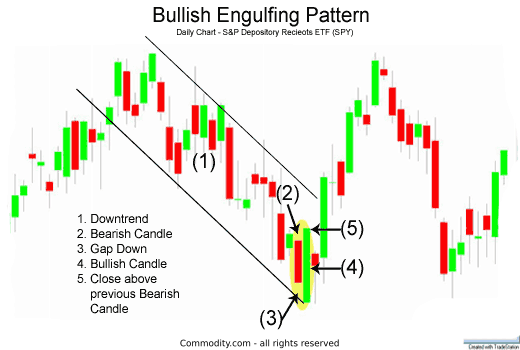The Bullish Engulfing Candlestick Pattern is a bullish reversal pattern, usually occuring at the bottom of a downtrend. The pattern consists of two Candlesticks:

- Smaller Bearish Candle (Day 1)
- Larger Bullish Candle (Day 2)
The bearish candle real body of Day 1 is usually contained within the real body of the bullish candle of Day 2.
On Day 2, the market gaps down; however, the bears do not get very far before bulls take over and push prices higher, filling in the gap down from the morning’s open and pushing prices past the previous day’s open.
The interpretive power of the Bullish Engulfing Pattern comes from the incredible change of sentiment from a bearish gap down in the morning, to a large bullish real body candle that closes at the highs of the day. Bears have overstayed their welcome and bulls have taken control of the market.
The chart below of the S&P 500 Depository Receipts Exchange Traded Fund (SPY) shows an example of a Bullish Engulfing Pattern occuring at the end of a downtrend:

Bullish Engulfing Potential Buy Signal
There are three main times when a trader might buy using the Bullish Engulfing Pattern; the buy signals that are presented below are ordered from the most aggressive to most conservative:
- A trader might buy at the close of Day 2 when prices rallied upwards from the gap down in the morning. Traders could interpret that the rally on Day 2 was significant and truly a reversal of market sentiment, if there was a substantial increase in volume that accompanied the large move upward in price (see: Volume).
- Secondly a trader might buy on the day after the Bullish Engulfing Pattern occurs; by waiting until the next day to buy, a trader is attempting to confirm that the bullish reversal and enthusiasm of the prior day is continuing and was not just a one day occurance like a short covering rally. In the chart above of the SPY’s, a trader might not enter the market long on the day after the Bullish Engulfing Pattern because the market gapped down significantly and even made new lows. A trader using methodology #2, would likely wait for a different potential buy signal such as the one presented in method #3 next.
- Thirdly, a trader might wait after the bullish engulfing pattern for another signal, mainly a price break above the downward resistance line (see: Support & Resistance), before entering a buy order.
An example of what usually occurs intra-day during a Bullish Engulfing Pattern is presented on the next page.
Intra-day Bullish Engulfing Pattern
The following 15-minute chart of the S&P 500 exchange traded fund (SPY) is of the 2-day period comprising the Bullish Engulfing Pattern example on the prior page:

- Day 1: As is seen in the chart above, Day 1 was a down day, even closing the day at the low (bearish sentiment).
- Day 2: The open was a gap down, very bearish sign; but the bulls appeared to have had enough because the price of the SPY’s went up the rest of the day, closing near the day’s highs (bullish sentiment) and higher than Day 1’s high.
The Bullish Engulfing Pattern’s opposite is the Bearish Engulfing Pattern (see: Bearish Engulfing Pattern).